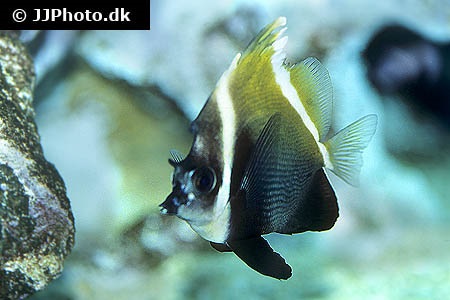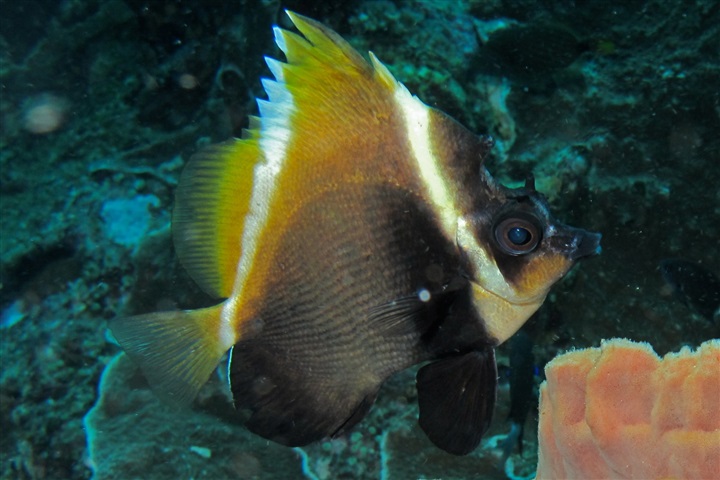Heniochus varius


| Latin name | Heniochus varius - (Cuvier, 1829) |
|---|---|
| Local name | Horned bannerfish |
| Family | Chaetodontidae - Heniochus |
| Origin | Australia, Japan, Indonesia, East Pacific, Central/West Pacific |
| Max length | 19 cm (7.5") |
| Minimum volume |
500 l (132 gal) |
|---|---|
| Hardiness |
Average |
| Suitable for aquarium |
Experience, preparation and extra care required |
| Reef safe |
Not reef safe |
| Aggressiveness | Docile but might be aggressive towards similar species of same gender |
| Recommended |
Other invertebrates Small crustaceans (Krill, mysis, artemia...) Zooplankton (Cyclops, pods...) |
|---|---|
| Mostly |
Large polyp stone coral (LPS) Soft coral Sponges |
This species likes to eat tubeworms.
This species sometimes nibbles at clams including Tridacna species.
These fish normally eat for the most part, coral polyps, therefore problems can arise in captivity when trying to give it an alternative food.
It is therefore essential to be well prepared before acquiring them and have several suitable food types ready to present them with.
However well prepared, there will be a large percentage, that will die after a short time in captivity.
It may mean having to keep living corals, mussels and zooplankton as food, in order to keep these fish alive whilst they are getting accustomed to alternative types of food.
This species must be fed with an appropriately varied diet.
This species will better acclimatize to the aquarium`s condition if introduced, when young.
Very small individuals can be very delicate.
This fish requires feeding several times a day, especially when newly added.
When the fish can find its natural food in the aquarium it requires less frequent feeding.
They can live as a pair provided they are introduced simultaneously.
This species needs good hiding places, for example, between live rocks.
This species revels in swimming and requires an aquarium with ample space.
This species is very shy and docile, so one should be careful when keeping it with more aggressive fish.
This species is well known for their long dorsal fin, hence the name Bannerfish.
The most interesting species of this genus are H. acuminatus and H. diphreutes, as they are the easiest to keep.
H. diphreutes, especially, is a good choice for aquarists who wish to keep Butterflyfish in a coral aquarium, as they are often reef safe if well fed.
The Butterflyfish are known for their attractive patterns and colours. They are closely related to Angelfishs, but can always be distinguished, as they lack the spines on each side of the head of the Angelfish.
A smaller group of these fish will seek out primairily soft corals, like Zoanthus. A larger part of the species will target different types of LPS corals. Butterflyfish are also known to seek out anemones, tubeworms and bristleworms.
Therefore it is important to choose the correct species in relation to the corals wanted, if one desires to keep Butterflyfish in a coral-aquarium.
Bristleworms, tubeworms and other small invertebrates are also a part of the diet for many Butterflyfish.
It can be problematic, with many of these species, to get them eating in the beginning, but many of the species cannot resist live zooplankton or live mussels with crushed shells. Another option is to mimic their natural behaviour by stuffing their food into coral skeletons or stones.
They ignore most other fish and are generally peaceful, therefore multiple Butterflyfish will have no problem living together. One should however be cautious about keeping similar species together unless they are a couple.
As these fish can be difficult to acclimatize and get feeding, it is important to buy healthy fish, to avoid having to deal with more problems. Make sure to check that they do not have parasites or any visible infections.
There are some species that should not be kept in an a aquarium, as they are food specialists and will almost always refuse to eat replacement foods. It can be possible to breed some species, which will eat frozen foods. Otherwise the only way to keep food specialists is by feeding them their natural diet, which consists of live SPS or LPS corals for example.
| Aquarium trade | Yes |
|---|---|
| Distribution | Pacific Ocean: Indonesia to the Society Islands, north to southern Japan, south to Rowley Shoals and New Caledonia; throughout Micronesia. Reported from Christmas Island in the eastern Indian Ocean (Ref. 5439). Replaced by Heniochus pleurotaenia |
| English common names |
Humphead bannerfish Hunchbacked coralfish |
| French common names |
Barbet souffré Poisson cocher cornu |
| Danish common names |
Brun vimpelfisk |
Bob Fenner. Bannerfish Butterflies, The Genus Heniochus - Wet Web Media - (English)
Scott W. Michael. 2004. Angelfishes and Butterflyfishes (Reef Fishes Series Book 3) TFH Publications / Microcosm Ltd. - (English)
Bob Fenner. Butterflyfishes; Separating the Good Ones and Those You Don't Want - Wet Web Media - (English)
Collection of links to additional information - Wet Web Media - (English)
Tea Yi Kai. 2014. Reef Nuggets 2: Aquatic Lepidopterans for your reef (Revised edition) - Reef Builders - (English)

